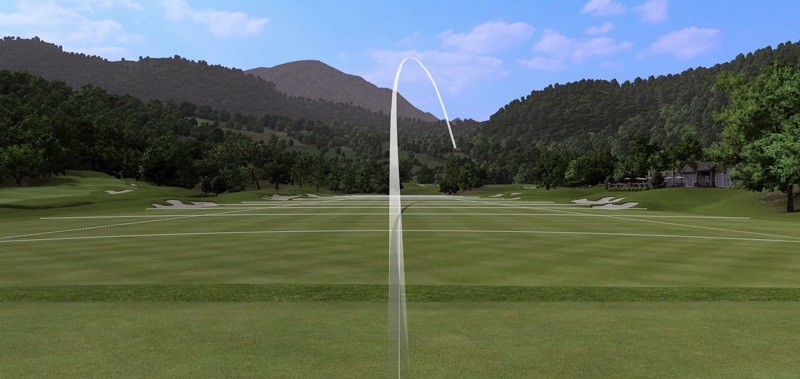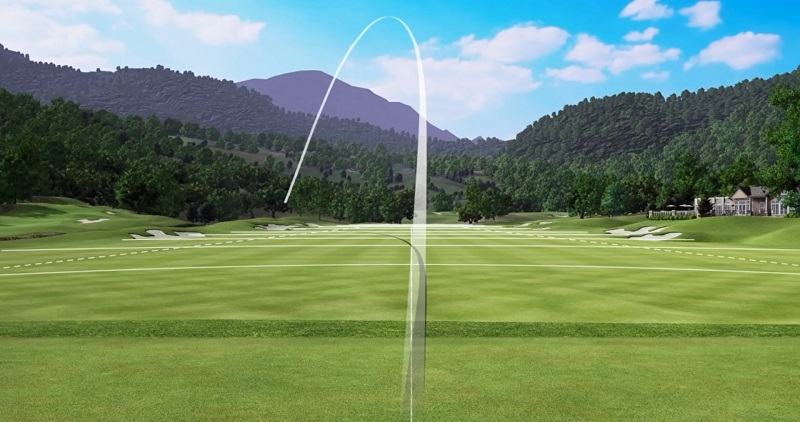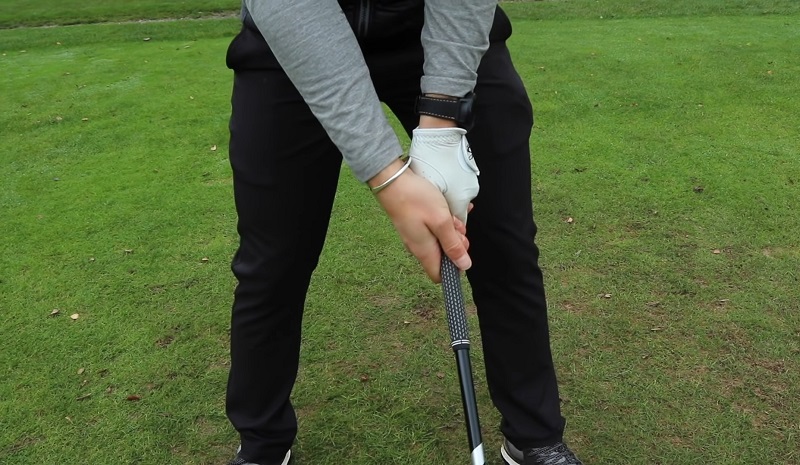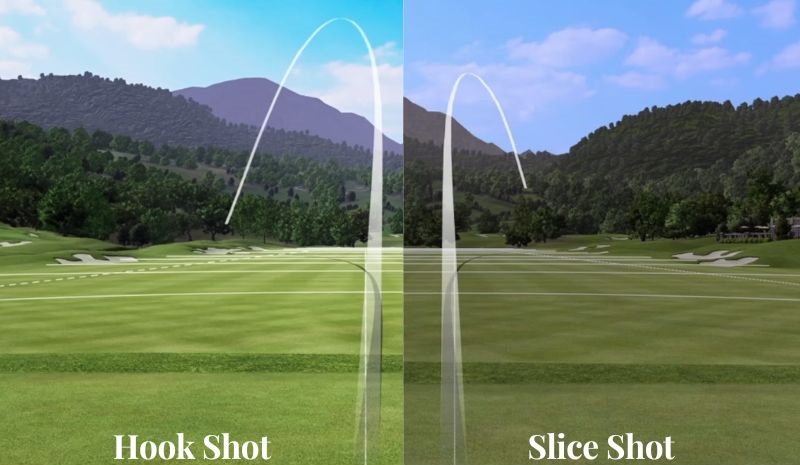Golf is a game of precision, and even the slightest misstep can have serious consequences. One of the most common mistakes made by amateur golfers is hitting either a slice or hook shot. Both of these shots can be equally frustrating as they often lead to poor results on the course. But what are slices and hooks, why do they happen, and how can you fix them? In this article, we’ll explore the differences between slice vs hook in golf so that you can gain greater control over your tee shots.
What Is A Slice Shot In Golf?

The slice shot in golf is a type of shot characterized by its distinctive curved trajectory that moves from left to right for right-handed golfers and right to left for left-handed players. It is usually an unintended result when the golfer’s clubface remains open at the moment of impact, causing the ball to spin toward the curved path.
The professional world of golf often views the slice as an undesirable shot due to its potential to obstruct the golfer’s target line and reduce their overall control over the ball.
This excessive movement is an amplified version of a “fade,” a more controlled and gentle curve to the right, which skilled golfers sometimes employ strategically.
In recent years, training practices designed to eliminate or mitigate slice shots have become increasingly prevalent, significantly enhancing golfers’ abilities in mastering an accurate and well-rounded game.
What Causes A Slice In Golf?
The primary cause of this undesirable shot is an open clubface upon impact with the golf ball, which imparts counterclockwise sidespin. This is often a result of an incorrect grip, poor body alignment, or an outside-to-inside swing path.
An outside-to-inside swing path, a common culprit of the slice, is created when the golfer’s body moves toward the target. At the same time, the club head moves across the ball from outside the target line. This creates an undesirable ball flight and challenging course corrections for players.
A golfer’s grip on the club is critical in determining the ball’s trajectory. An overly tight or weak grip can result in a slice. Additionally, standing too close or far from the ball while setting up the shot could impact the swing path and lead to a slice.
What Is A Hook Shot In Golf?

The hook shot in golf is the exact opposite of a slice, as it curves from right to left for right-handed players and leaves to the right for left-handed players. Similar to a slice, the hook shot is often an unintended consequence of the club face remaining open at the time of impact.
A hook is essentially an exaggerated version of the “draw” shot, which features a controlled, gentle curve to the left, allowing skilled golfers to navigate obstacles and approach the green with precision.
This unwelcome exaggeration can deviate your shot drastically to the left, not only sabotaging your well-calculated aim but also abruptly altering the course of your gameplay.
What Causes A Hook In Golf?
The main causes of a hook can typically be traced back to three distinct issues – grip, swing path, and clubface.
An overly strong grip – where the hands rotate excessively to the right for right-handed players (or the left for left-handed players) – can cause the clubface to close at impact, sending the ball on an undesirable leftward trajectory.
An incorrect swing path, particularly one that approaches the ball from an excessively in-to-out motion, can contribute to producing a hook shot.
Finally, the position of the clubface at impact plays a crucial role in shaping the ball’s flight. A hook will likely ensue if the clubface closes too much relative to the swing path.
How To Fix Golf Slice Vs Hook?

Many golfers experience difficulty with slices or hooks. To get your shot back on track, we strongly suggest focusing on the fundamentals: grip, setup position, and swing mechanics.
These tried-and-true methods can help you find the sweet spot by looking at how different elements of your technique interact.
Grip
It’s been observed that struggling golfers often experience challenges due to a grip that’s either too weak or too strong, yielding issues like an overly open or closed clubface at impact. Specifically, these golfers are inclined to exhibit a weaker grip, causing limitations in their game. To rectify this, they should focus on honing and perfecting their grip.
As the simplest yet most influential aspect to improve in golf, achieving a relatively neutral grip can produce incredible ball striking and overall success. By revisiting the fundamentals and building a strong foundation, golfers will inevitably experience notable enhancements in their gameplay.
Setup Position
A common mistake involves golfers hooking the ball off the tee due to poor ball position. To avoid this, it is important to adhere to a simple rule of thumb when teeing up with the driver: ensure the ball is placed approximately two golf ball lengths ahead of the center of your stance or in line with the inside of your highest heel. This strategic positioning allows for better control and more consistency in your swing.
When the ball is positioned too far forward in your stance, such as off the front foot or beyond, the club face has additional time to close, increasing the likelihood of hooks. To truly enhance your golfing prowess, pay close attention to the ball position and watch as the trajectory of your game takes off.
Swing Mechanics
The most significant factor in golf is the swing path. The degree of inside-out or outside-in contact made with the ball in relation to your target line directly influences the direction and shape of the shot. An outside-in swing path will usually result in a slice, while an inside-out swing path is more likely to produce a hook.
Once you are aware of the direction your swing is taking, it’s time to make sure your mechanics are up-to-par. To ensure precision and accuracy in the golf ball’s flight, you should focus on the quality of your backswing, downswing, and follow-through. It’s also a good idea to analyze your swing on slow-motion video, as this can help you identify critical areas for improvement.
Common Mistakes To Avoid When Trying To Fix Your Slice Vs Hook In Golf
Keeping your head down is amateur golfers’ most significant mistake while attempting to fix their golf slice and hook. While it’s true that keeping a steady head can help you maintain balance, you should also remember to focus on what your upper body is doing. Many golfers need to recognize the importance of their arms and shoulders in producing a powerful, consistent swing.
Golfers should also avoid excessively focusing on the clubface. Many golfers think that all they need to do to fix their shots is alter the angle of the clubface. However, this will not necessarily fix the shot. The clubface is only one piece of the equation, and a solid swing requires attention to grip, setup position, and mechanics.
The last important to remember is that there is no one-size-fits-all solution. Every golfer is unique, and thus every golf game requires individualized attention. Ensure also to avoid common mistakes like overcorrecting or relying too much on the advice of others. If a certain tip or technique isn’t working for you, move on and try something else instead.
Final Thoughts
Slice vs hook in golf can be extremely frustrating for amateur golfers. To ensure your shots are always on-par, it’s important to focus on the basics and avoid overcorrecting.
With careful attention, practice, and patience, golfers can play precisely and accurately. Remember to always enjoy the game – that’s what it’s really all about! Good luck on the course, and happy golfing!


